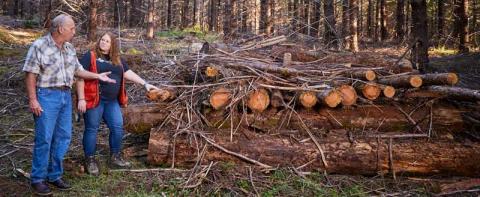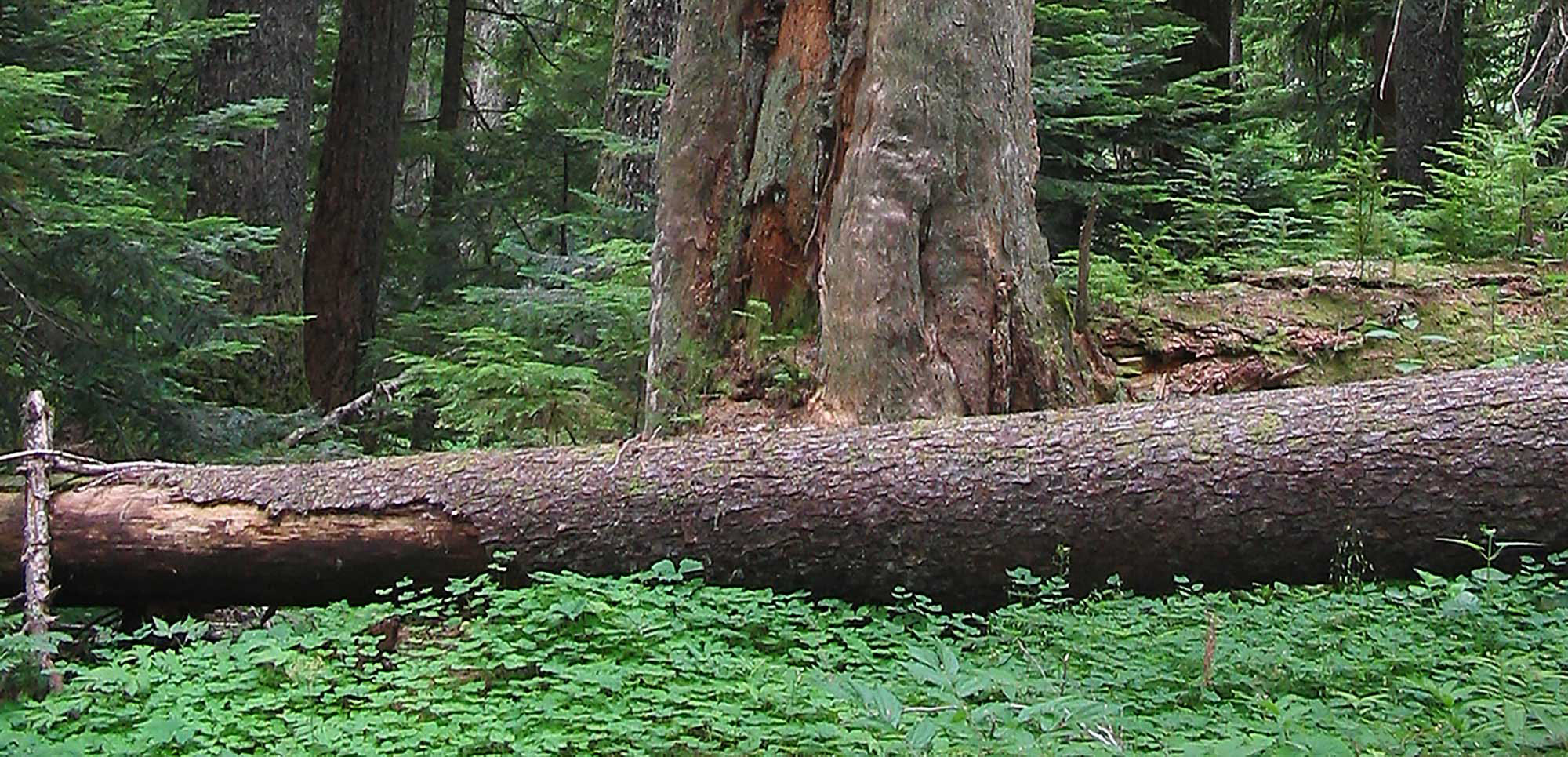Wildlife habitat is highly variable. In fact, the entire landscape may be considered habitat, because different wildlife species and communities interact with the land and one another in multiple ways — from a drainage basin to a river valley, to a watershed within the valley, to a riparian area associated with a single stream. Many species will use a variety of habitat types to complete the functions of their daily lives (e.g., foraging and nesting may utilize two or more habitat types). And, more broadly, species may migrate or expand their territories during certain times of the year as part of their life cycle. Habitat is a shifting mosaic over time, as forests and other landscapes move through natural and human-altered timelines.
Many habitat goals are mutually exclusive; what improves conditions for one species of wildlife may degrade them for another. Not every wildlife species is (or can be) present on every acre at any point in time. We suggest that forest landowners and managers consider the array of opportunities presented by their forest’s ecological context, along with their own management objectives, and select those efforts that have a reasonable chance of success. Effective management focuses on balancing timber production with conservation efforts, protecting water quality, and preserving this unique ecosystem.
Westside habitats
Oregon's westside habitats are characterized by their lush forests, abundant rainfall and diverse ecosystems. Spanning the Coast Range to the western slopes of the Cascades, these habitats include towering Douglas-fir forests, riparian zones, wetlands, and unique landscapes like oak woodlands and coastal dunes. Home to a variety of wildlife, including salmon, owls and elk, westside habitats support rich biodiversity.
Westside Douglas-fir Forests and Wildlife
Oregon’s westside Douglas-fir forests are one of the most productive and economically important forest types in the world and are common in the state. These forests also provide habitat for a wide range of wildlife species. This resource discusses management tools for family forest landowners.
Coastal Douglas-fir Forests and Wildlife
In coastal Douglas-fir forests, diverse habitats can be enhanced by using silviculture systems that let you manage both forest resources and wildlife. These systems can provide landowners with financial return while also protecting wildlife.
Riparian Areas: Fish and Wildlife Havens
If your property includes water such as a pond or stream, part of your land is riparian. This publication tells how riparian areas provide essential fish and wildlife habitat, and how land use can affect this habitat, and briefly describes management practices that protect or enhance habitat.
Wetlands as Varied as Our Region
This bulletin provides some basic information about wetlands and identifies management techniques that protect the functions and values of these lands.
Wildlife in Broadleaf Woodlands of Oregon and Washington
Of all the habitats in Oregon, perhaps the most wildlife-friendly is the broadleaf woodland. Today, large tracts of pure broadleaf woodlands exist in very few places. This bulletin provides more information on this important habitat.
Eastside habitats
Oregon's eastside habitats encompass diverse ecosystems ranging from the arid sagebrush steppe to forested slopes of the East Cascades and Blue Mountains. These habitats are defined by their unique climate, geology and vegetation, supporting a variety of wildlife species adapted to dry, rugged landscapes. Forests in the eastside regions include ponderosa pine, western juniper and aspen groves, while riparian areas provide vital resources for fish, birds and mammals in an otherwise arid environment. Managing eastside habitats involves addressing challenges such as wildfire risk, invasive species and changing climate conditions, all while balancing conservation with sustainable land use practices.
Wildlife-friendly Fuels Reduction in Dry Forests of the Pacific Northwest
Reducing fuels, improving forest health and enhancing wildlife habitat are common management goals on private dry forests. These goals don’t have to contradict each other, if you follow some simple guidelines. This publication will give you tips and ideas on how to make sure you can meet all your goals.
Managing Ponderosa Pine Woodlands for Fish and Wildlife
Proper management practices for ponderosa pine woodlands can help maintain or create fish and wildlife habitat and provide a continuing supply of wood products. This publication provides information on how to manage your ponderosa pine stand to improve wildlife habitat.
Managing Western Juniper for Wildlife
Western juniper can provide valuable habitat for many wildlife species. However, too many trees cause the loss of important understory plant species, a loss that can degrade wildlife habitat. When managing juniper woodlands for wildlife, it’s important to maintain a balance of plant layers, including wildflowers, grasses, shrubs and trees. This publication provides information on managing western juniper woodlands to improve habitat for a maximum number of wildlife species.
Riparian Areas: Fish and Wildlife Havens
If your property includes water such as a pond or stream, part of your land is riparian. This publication tells how riparian areas provide essential fish and wildlife habitat, and how land use can affect this habitat, and briefly describes management practices that protect or enhance habitat.
Wetlands as Varied as Our Region
This bulletin provides some basic information about wetlands and identifies management techniques that protect the functions and values of these lands.
Oak habitats
Oregon's oak habitats, including oak savannas and woodlands, are among the state’s most iconic and ecologically important landscapes. Dominated by Oregon white oak, these habitats support a diverse array of wildlife, including acorn woodpeckers, western gray squirrels, and pollinators like bees and butterflies. Oak habitats are often interspersed with grasslands and shrublands, creating a mosaic that fosters rich biodiversity. Historically maintained by periodic fire, these habitats now require active management, such as removing invasive species and preventing encroachment by conifers, to remain healthy and productive.
Oregon White Oak and Wildlife
The graceful, spreading Oregon white oak presides over many landscapes in the Pacific Northwest and anchors many rich native habitats. This species provides habitat for more than 200 wildlife species, including insects, birds, small mammals, reptiles and amphibians. Due to their ability to survive drought and fire, plus their long-lived nature, a mature oak tree can live up to 500 years while supporting a multitude of species. Read this article to learn more.

Habitat tools
The following publications and resources provide guidance on actions landowners can take to intentionally manage wildlife habitat:
Techniques and Tools for Monitoring Wildlife on Small Woodlands
Monitoring wildlife can provide many unique insights into the health and productivity of forestland. This publication offers ideas and tools to help.
Enhancing Wildlife on Private Woodlands
Whether you manage land for game, nongame or pest species, the objective is to increase, decrease or maintain numbers of wildlife. This publication discusses techniques for wildlife enhancement.
Grass Seeding Forest Roads, Skid Trails and Landings in the Inland Northwest
Sediments are one of the main nonpoint sources of pollution for lakes, rivers and streams in the inland Northwest. This publication shares strategies for protecting waters by seeding forest roads, skid trails and landings. Tables specify ideal mixes of plants best suited for overstory, understory and legumes, so the environment is protected while wildlife and livestock find nourishment.
The Wildlife Garden: Build Nest Boxes for Wild Birds
Nest boxes are a great way to attract wild birds to your yard. They provide birds with shelter and a place to raise their young. Birds that use nest boxes include chickadees, wrens, bluebirds, swallows, wood ducks and owls. This publication includes plans to build your own nest boxes.
Woodland Ponds: A Field Guide
This field guide describes in detail the steps woodland landowners can take to build a large pond on their property. The guide describes planning, permitting and construction of a pond, and includes sections on maintaining and repairing woodland ponds. It also describes the aesthetic values and benefits to wildlife that woodland ponds provide.
Oregon Forest BioDiversity Explorer
The Oregon Forest BioDiversity Explorer provides data on species occurrences and/or modeled distributions for Oregon's important forest species and habitats.
Oregon Conservation Strategy
The Oregon Conservation Strategy, developed by the Oregon Department of Fish and Wildlife, is an overarching plan to conserve Oregon’s fish and wildlife and their habitats. It combines the best available science and conservation priorities with recommended voluntary actions and tools for all Oregonians to define their own conservation goals.
ADDITIONAL RESOURCES:
PUBLICATIONS
Wildlife in Managed Forests: Oregon Forests as Habitat
As the cornerstone publication for the Oregon Forest Resources Institute's Wildlife in Managed Forests series, this booklet provides a background and context for better understanding the role managed forests play in providing habitat for wildlife. The reader is introduced to an overview of priority actions for wildlife that can be implemented on any age or size of forest. It also provides forest landowners with suggestions for wildlife management planning goals and employs a series of case studies of Oregon landowners who have applied these techniques and goals on their own lands.
Family Forests and Wildlife: What You Need to Know
Family forest landowners have many reasons for owning forests. Enjoying wildlife and providing wildlife habitat consistently rank as top motivators. This publication, the cornerstone in a series by the Woodland Fish and Wildlife Group, will give you some ideas on where to begin as you decide how to best manage your woodland for wildlife habitat.
VIDEOS
Forests as Habitat for Wildlife
Explore the diverse wildlife habitats found across Oregon’s forests, learn tools for managing habitat at all forest ages, and discover how management actions can benefit wildlife and align with landowner objectives.
An Introduction to Wildlife Habitat Enhancement
An introductory video for landowners from the Oregon State University Extension Service.
Steps to Improving Wildlife Habitat on Your Property
A video full of tips and ideas for encouraging wildlife on your property. Provided by the Oregon State University Extension Service.

